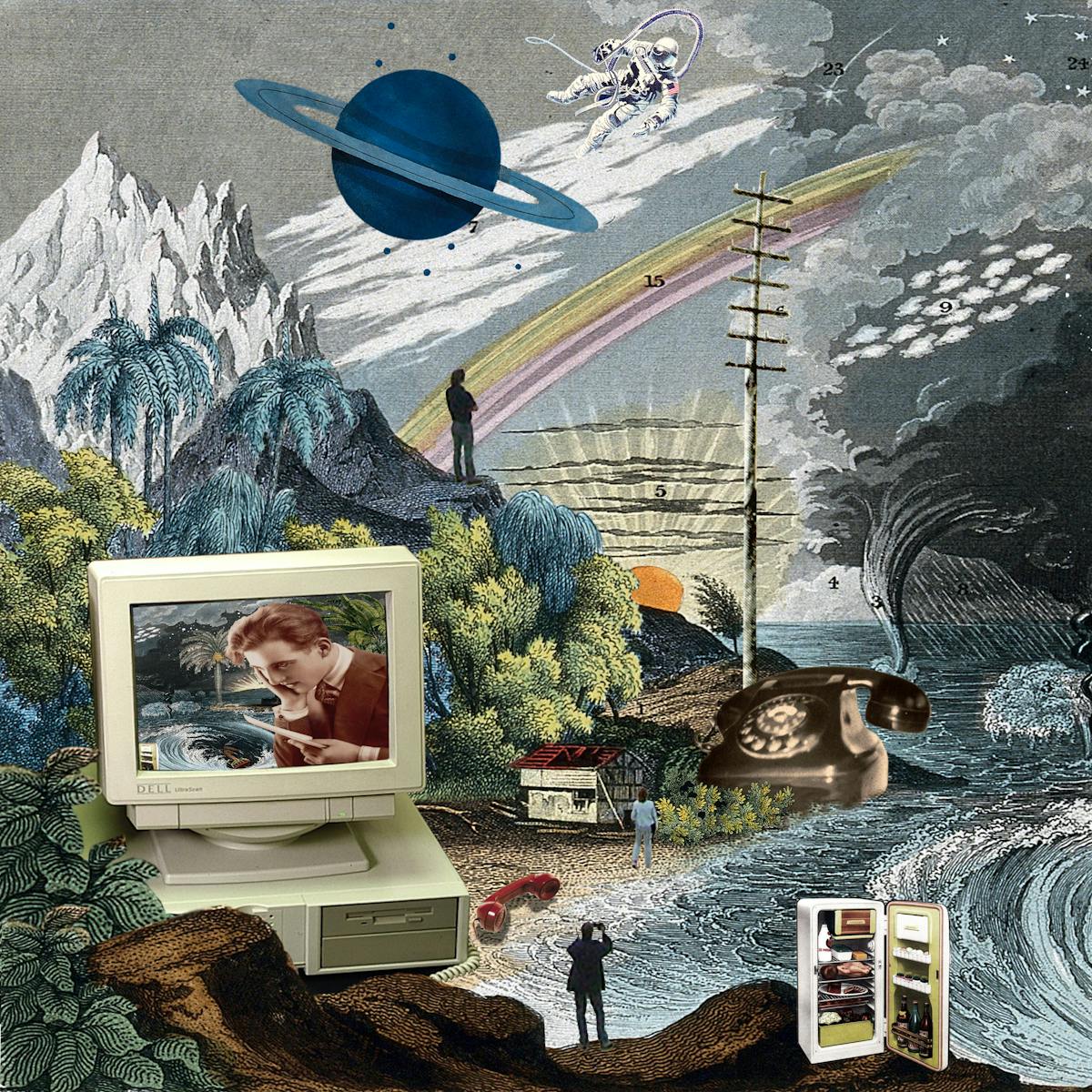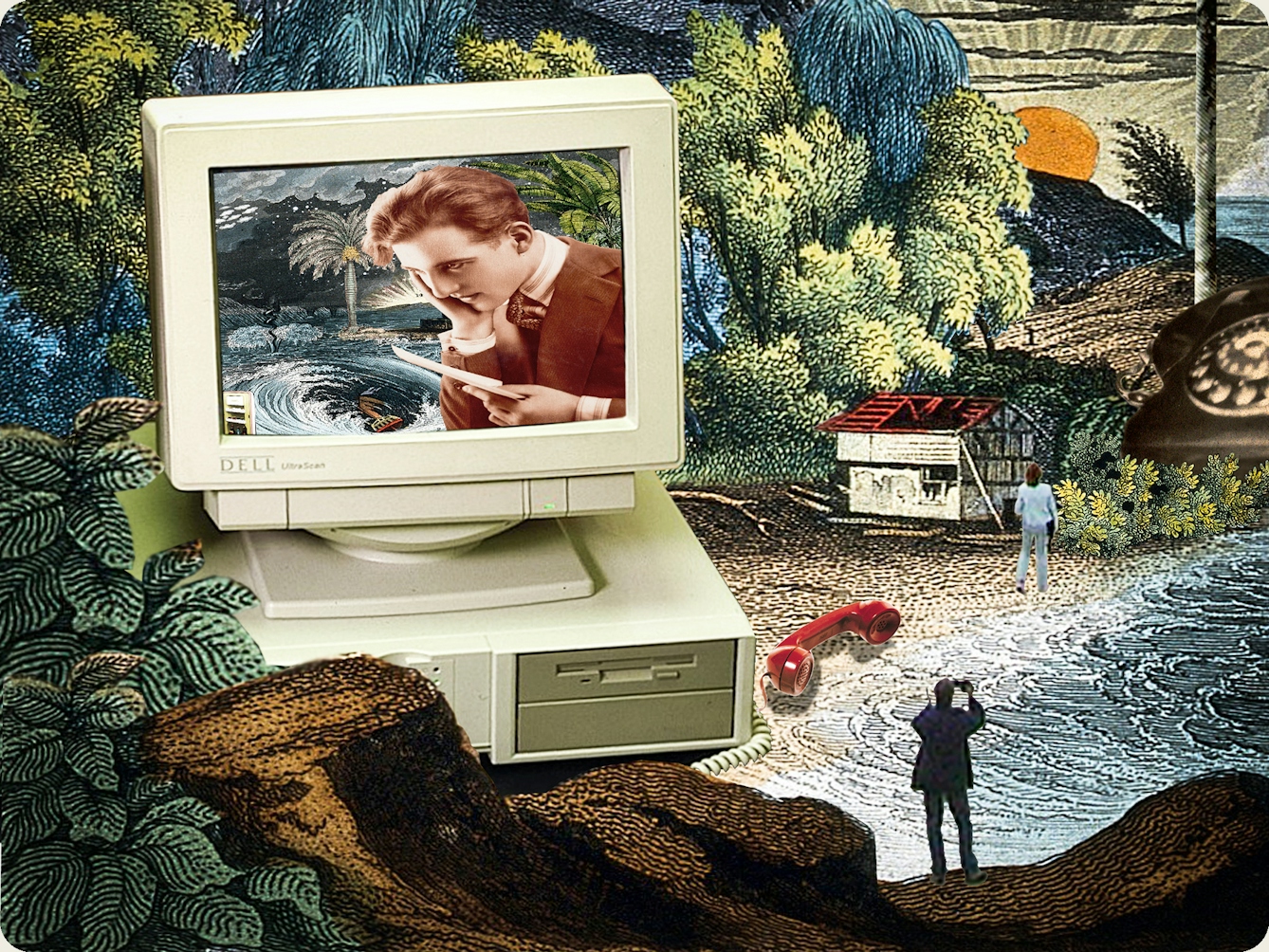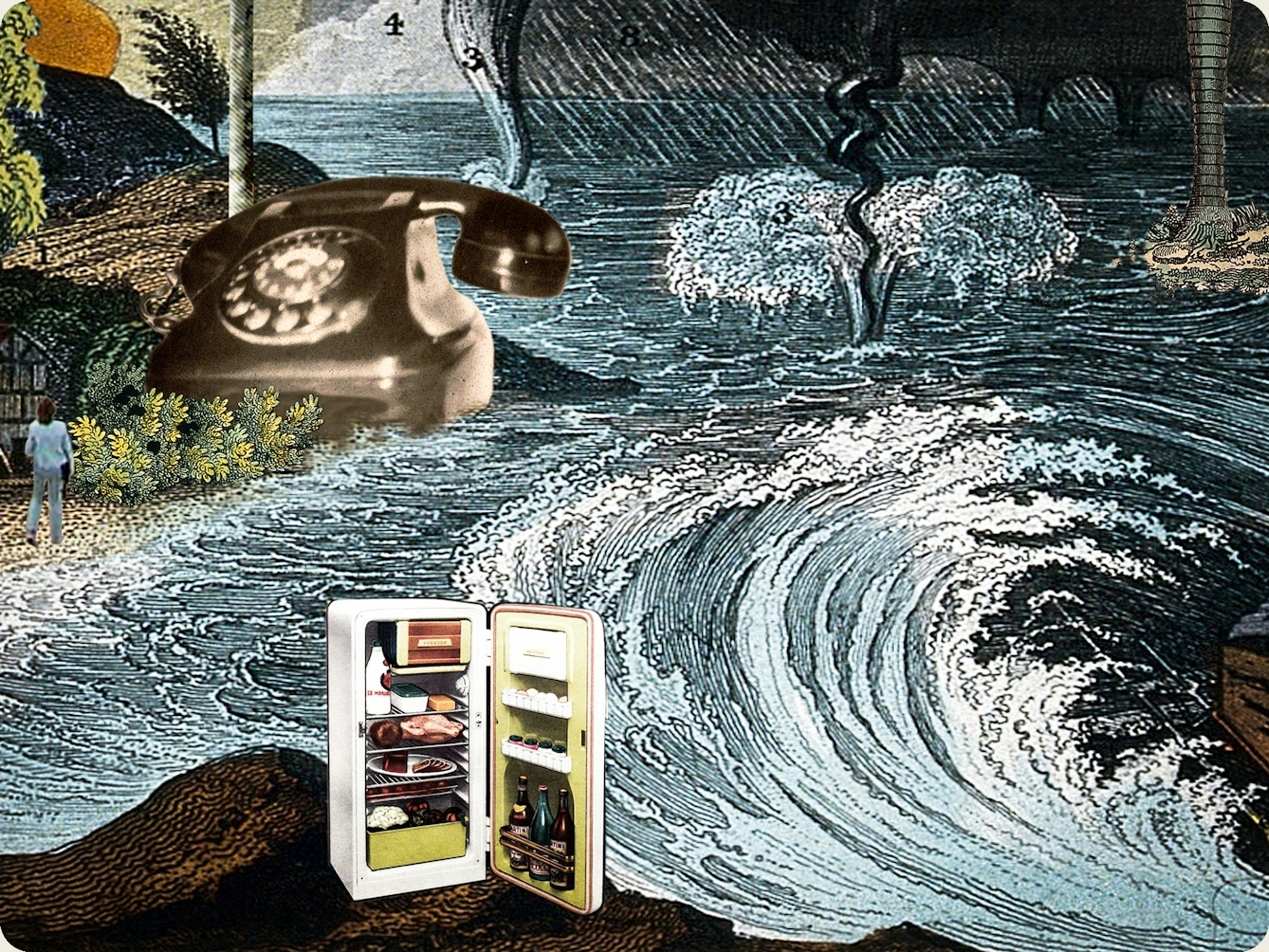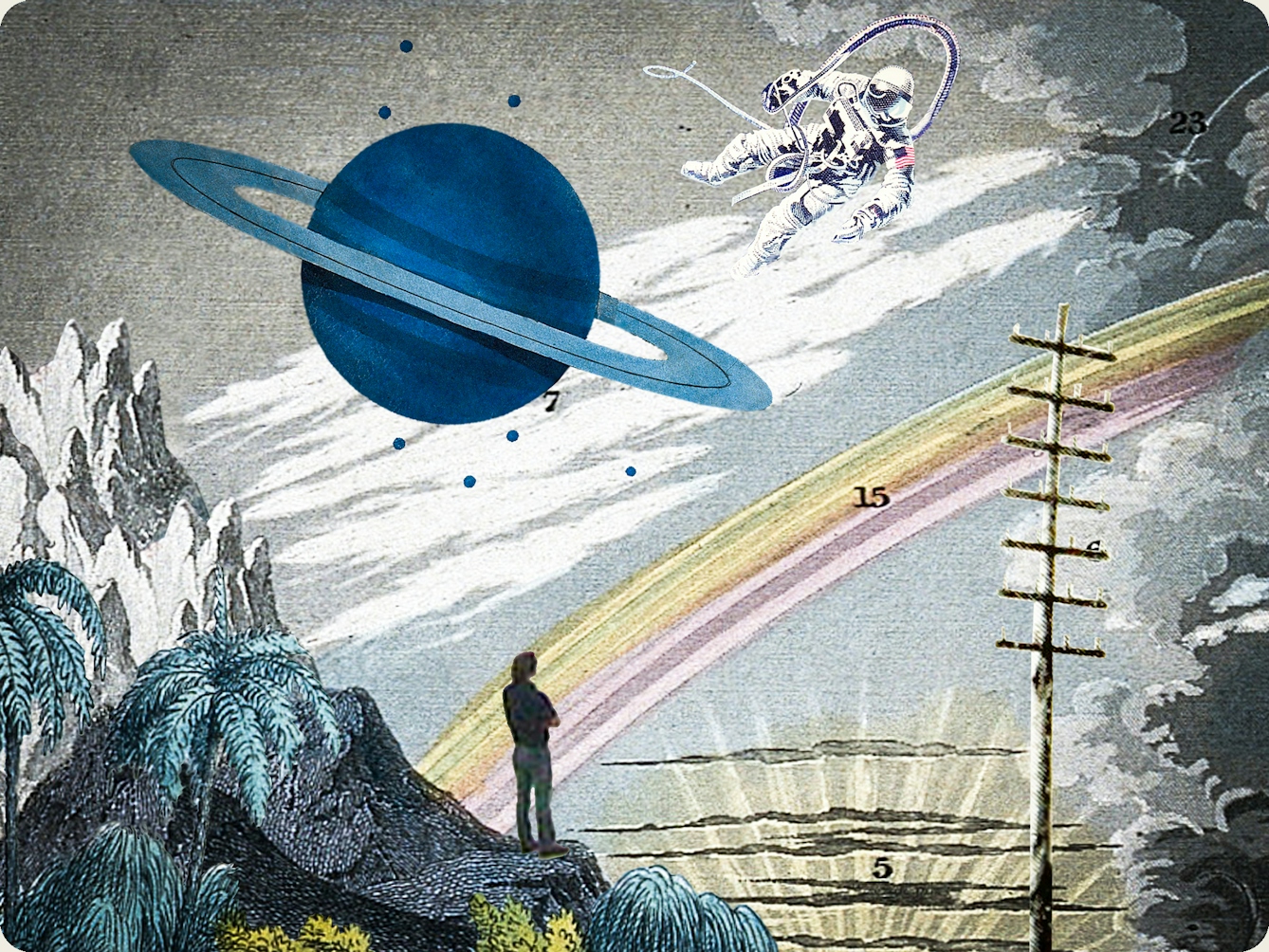In the final part of the series Gail Tolley considers whether technology is a magic bullet for homesickness. And, as she continues to explore this peculiarly 21st-century condition, she reflects back on her journey through the phenomenon, and finds reason for hope.
Finding a cure for homesickness
Words by Gail Tolleyartwork by Maria Rivansaverage reading time 8 minutes
- Serial

Did you know the video call was first conceived in 1870? Back then, science-fiction writers envisaged a machine that could transmit pictures and sound from one place on earth to another. It was – somewhat clunkily – called a telephonoscope.
Fast forward (or maybe that should that be Zoom forward) to 2020, and we’ve embraced the ‘telephonoscope’ as never before. In March this year, with much of the world under lockdown amid the coronavirus pandemic, video calls increased (according to some accounts) by 1,000 per cent.
At first glance, technology might seem to offer a solution to missing the people and places we love. It means we can be in touch anywhere, any time (depending on your internet connection). So it would make sense to think that technology could be a cure for homesickness. Sadly, it’s not that simple.
A false friend
As we’ve embraced this new(ish) way of communicating, many of us have come to realise something: it’s not quite the same as the real thing. As a child I remember feeling that a phone call home just didn’t get rid of that longing to be back in a familiar environment. And during lockdown, a virtual catch-up with friends left me missing the pub even more than before.
Why is this? Susan Matt is the author of ‘Homesickness: An American History’ and also of ‘Bored, Lonely, Angry, Stupid’. The latter is co-written with Luke Fernandez and comes with the subtitle: ‘Changing feelings about technology, from the Telegraph to Twitter’. She seemed the perfect person to comment on the intersection of homesickness and technology.
“In the age of digital media we think, ‘Oh I could be anywhere. It doesn’t matter where I am as long as I have the technology,’” she tells me. It turns out, that view is nothing new. “It goes back to the 19th century when people said, ‘Now the telegraph is here, we’ll conquer nostalgia because we have instantaneous communication.’ We held out hopes for the phone and the airplane too.”

“At first glance, technology might seem to offer a solution to missing the people and places we love. Sadly, it’s not that simple.”
But advances in technology are actually a false friend when it comes to homesickness. “These things make us think that moving will be easier than it is. But we still find that familiar landscapes have a hold on us and can't just be simulated.” She concludes: “Where we are does really affect how we feel.”
Medical historian Fred Cooper believes the relationship with technology and homesickness is a complicated one. His work on the Beacon Project – which looks at loneliness among students at Exeter University – has found that technology brings both benefits and drawbacks.
“In some ways it addresses aspects of loneliness – it’s always good to talk to people. But it doesn’t address that environmental and cultural feeling of loss,” he says. “It can be used as a bit of a crutch and then affect how you interact with other people.” Other research backs up both Matt’s and Cooper’s views. It’s been noted that within immigrant communities, calling home happens more than ever, but there hasn’t been a corresponding decline in mental illness.
Beyond technology
If technology doesn’t offer a cure, then what other ways are there to deal with homesickness? Dieu Hack-Polay, an associate professor at Lincoln University, advocates for homesickness to be treated as an illness, an approach that struck me as having a lot in common with the views on nostalgia back in the 19th century.
He believes that by placing home at the heart of treatment, it’s possible for migrants to more easily deal with the stress of a new country. He tells me about working with those who’d come to the UK during the Bosnian War in the 1990s. By connecting with aspects of home in their new environment, settling into life in the UK became easier.
“They can replicate some of the elements that they have from home so that this can also become home. This transition then helps them to visualise the new place not so much as a strange place. So they start to go to community centres that speak their languages, that have their food, and that helps relieve them from a state of stress that is linked to the fact that they miss home.”
Perhaps looking for a quick fix for homesickness misses the point. The very nature of home – rooted in place and made up of a myriad of components – means that it’s hard to replicate elsewhere. Maybe it’s better to accept our strong ties to home. And also to appreciate the silver linings that homesickness might have.

“Some of the elements from home help them to visualise the new place not so much as a strange place. Community centres that have their food helps relieve them from a state of stress that is linked to the fact that they miss home.”
Peter Suedfeld, Professor Emeritus of Psychology at the University of British Columbia, has spent his life examining how humans adapt to living in inhospitable places. He thinks we shouldn’t overlook the benefits that going through a period of homesickness can bring. Suedfeld believes it can be a time of great personal growth.
He points to astronauts who’ve had transcendental experiences during their missions in space and individuals who’ve survived a period in Antarctica and found a passionate appreciation for the natural environment. Even if you’re going through more mundane experiences, Seudfeld says, individuals often realise they can cope with problems they never thought they were able to deal with.
The biggest silver lining, in my opinion, though, is how homesickness can give us a new appreciation of home. How it throws into sharp relief the importance of the aspects of home – and, in turn, our lives – that it’s easy to take for granted.
There was one stark reminder of this early in the coronavirus pandemic: the footage on television of travellers desperate to board repatriation flights. The thought of being abroad and not knowing when or if you can return is an undeniably distressing scenario. And no number of Zoom or Facetime calls will rectify that.
A condition for our times
‘Homesickness’ is not widely discussed in 2020, but ideas of home and being separated from home are everywhere. As well as the experiences of homesickness laid out in previous chapters, I came across other scenarios connected to the condition, which felt very now.
Glenn Albrecht, an academic in Australia, believes you could be homesick without even leaving home. Albrecht, an environmental philosopher from New South Wales, coined the term ‘solastalgia’ to describe the experience of your home being transformed by environmental change. Inspired by the word ‘nostalgia’ and incorporating the word ‘solace’ – it describes a form of homesickness that comes about when the place you live is destroyed around you, when you can no longer find solace in your home.
Psychologist Guilaine Kinouani, founder of the organisation Race Reflections, has written about the experience of internal displacement that comes about due to systemic racism. She believes that living in a world with racial inequality and injustice can, for Black people, feel like being adrift and displaced. She describes it as epistemic homelessness. Another kind of homesickness still.

“We shouldn’t overlook the benefits that going through a period of homesickness can bring. Suedfeld points to astronauts who’ve had transcendental experiences during their missions in space.”
Right now, across the world, millions of stories of uprootedness and disconnection are playing out. Homesickness feels like a condition of our times.
Right now, across the world, millions of stories of uprootedness and disconnection are playing out. Homesickness feels like a condition of our times.
Back in the 19th century the idea was commonplace, and I can’t help but think that we could benefit from bringing it back. Not in the limited sense that it was once used, but in a new, fit-for-the-21st-century sense. An understanding of homesickness as it’s experienced for the migrant worker, the refugee, the student and even the astronaut. Homesickness as something that we all might experience in an increasingly connected – but displaced – world.
The human capacity to adapt
My journey through homesickness hasn’t only thrown up stories of sadness and despair, though. It has also introduced me to tales of adaptability, resilience and, at times, even transformation. I won’t forget the account of the Acholi tribe passing down their longing for their homeland to generations who hadn’t even been there. Or the image of a group of scientists in a space simulation in the Canadian Arctic attempting to create poutine from powdered milk.
And I don’t think I’ll forget the delicate prints by Zarina, recreating with such care the floor plans of her home in India. Leaving home causes us to lose something, but in response we build new things, form new connections and tell new stories.
Twenty-six years after I was faced with a sleepover I was dreading, homesickness for me is, thankfully, a distant memory. I was determined to embrace travel as I got older and eventually I shook off homesickness’s hold. The idea of a night away from home thrills me nowadays.
Even at a time when movement is restricted across the world, I still have a pile of travel books and magazines on my desk. Homesickness inadvertently turned me into a lover of the open road, but it also taught me how sweet it is to come home.
About the contributors
Gail Tolley
Gail Tolley is a travel and culture writer based in Edinburgh. She has twice been the editor of popular culture magazines: Time Out London (2017–19) and The List (2012–14). She has contributed to National Geographic Traveller, the Independent and BBC Radio 4. Alongside working as a freelance writer and broadcaster, she also works in TV development.
Maria Rivans
Maria Rivans is a contemporary British artist known for her Surrealism-meets-Pop-Art aesthetic. With its unique approach to collaging, her artwork intertwines fragments of vintage ephemera, often with reference to film and TV, to spin bizarre and dreamlike tales. She exhibits work throughout the UK as well as internationally, including Hong Kong, New York and across Europe. Notable solo shows include the Saatchi Gallery, London and Galerie Bhak, Seoul.







